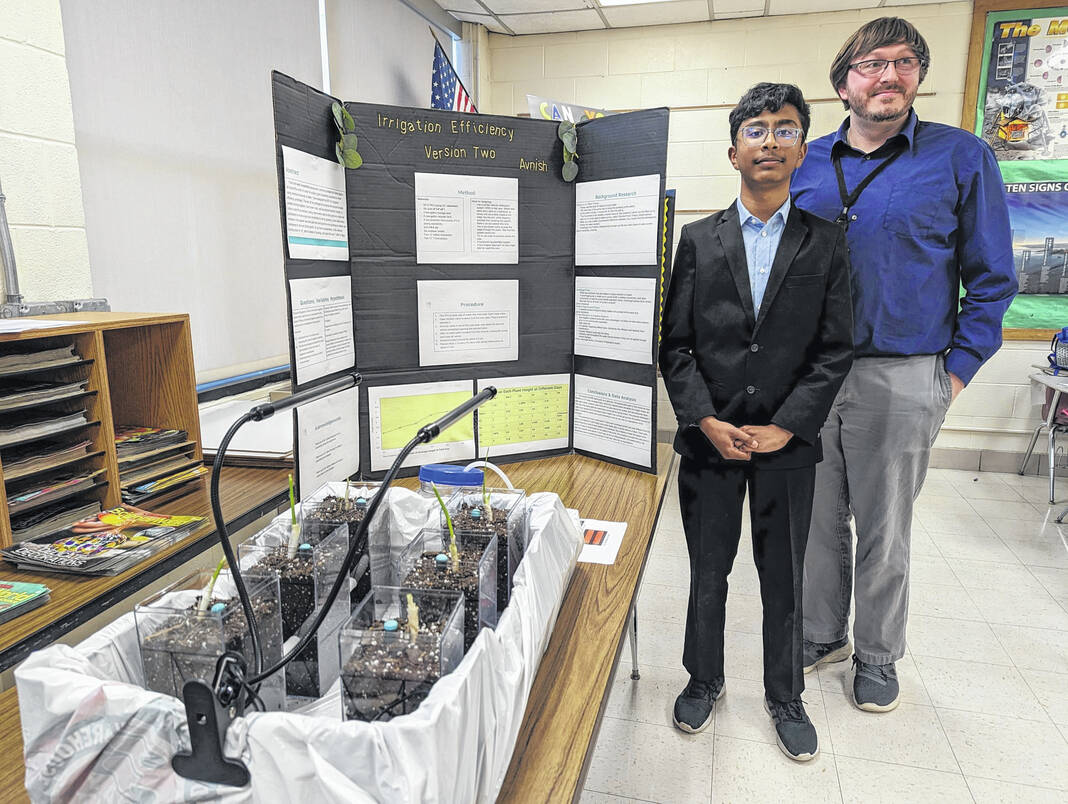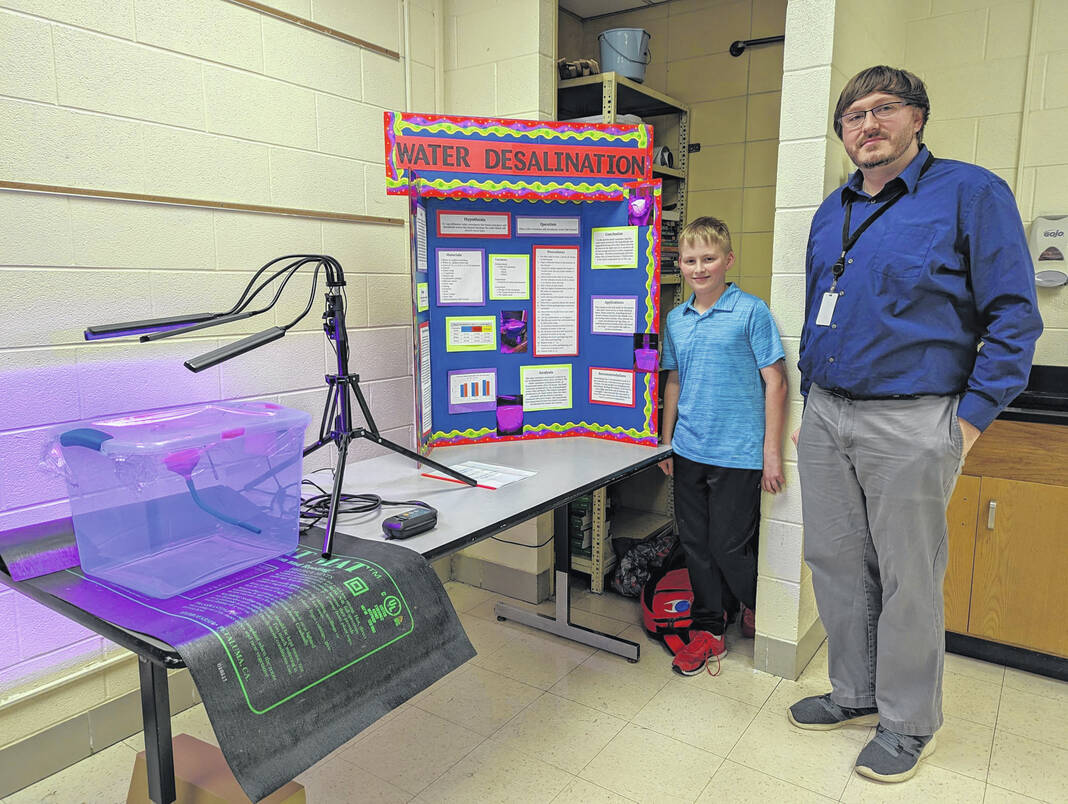
Perrysburg Junior High School Science Fair contestant Avnish Shendge, left, shows off his superior ranking fair entry, “Irrigation Efficiency Version 2.0,” with 7th grade science teacher Corbin Brangham.
Roger LaPointe | Sentinel-Tribune

Perrysburg Junior High School Science Fair contestant Isaiah Lake, left, shows off his superior ranking fair entry, “Solar Powered Water Desalination,” with 7th grade science teacher Corbin Brangham.
Roger LaPointe | Sentinel-Tribune
PERRYSBURG — If you were to ask what cookies, heat lamps and irrigation have in common, Perrysburg Junior High School 7th grade science teacher Corbin Brangham would tell you they were each part of the school’s science fair club projects.
For the last two years Brangham has been hard at work establishing an extracurricular science fair club at the school.
Last year was the first year for the club, and five students took part. This year there were also five students, but four projects. Two students teamed up to collaborate on a project.
The students choose to do this. Brangham is a fan of their being self-selected, and not required to do the activity.
“They have to do all their own background research. Some even changed their topic,” Brangham said. “They came and they stuck it through.”
Preparation starts for the students in September.
The club is something Brangham’s been wanting for the school since he started at PJHS, when he found out there wasn’t a club. He had assisted with the science fair club when he worked at the Horizon Science Academy. When he wanted to get the activity going in 2020, everything was still shut down for the pandemic.
“That third year, yeah, it was time to do it,” Brangham said. “I’d seen science fairs and I’d judged science fairs, so I really wanted to bring that experience to the students here and give them that opportunity.”
All of the five students take the same 7th grade science class, but Brangham wanted to give them the opportunity to do more.
“It gives them an opportunity to explore something that they are interested in. In regular science class we have a curriculum we have to follow. We can have explorations within that, but it’s very directed,” Brangham said. “Since they have that independent exploration they get to investigate whatever topic they are interested in, and they get way more in-depth that what we have time for in class.”
He’s a serious fan of the scientific method and teaching that to the kids. For Brangham, that means detail.
“You see that with the experiments, there’s no way we can get into that level of detail with anything,” Brangham said
The students have to do their own experiment, and that is where Brangham gets excited. It’s contagious to the kids.
“They design the experiment, instead of the teacher designing the experiment for them to do. So it gives them the opportunity to take charge of their own learning, in a way that is very difficult to do in a classroom,” Brangham said. “That’s what scientific method is.”
The students are proud of their work, and their independence shows through, physically, when they explain, show off and describe the results of their fair entry experiments.
”My project was, ‘Can you blame the cookie sheet?’ I tested the difference in cookie sheets and how they cooked the cookies,” student Michaela Lake said. “When I would cook cookies I would always see a difference in how they turned out. So I wanted to see if it was the cook, or the cookie sheet.”
She tested a variety of metals and stoneware.
Avnish Shendge, an eighth-grader, submitted his second fair entry, “Irrigation Efficiency Version 2.0.”
“My project is about testing a new type of irrigation system that is highly cost efficient and water efficient,” Avnish said. “This is actually a continuation of my project from last year. I felt like helping the world out with problems of world hunger and water potability is really important.”
Eighth-graders Ria Khatri and Maanya Parikh did a collaborative project.
“Our project was about the effects of material on water quality. We tested it by putting water in various materials of cups, putting the samples in Petrie dishes and a few days later seeing which varied the most and the least,” Ria said.
They tested for a variety of bacteria.
They came up with the project because of some “funny tasting water.”
Maanya said, “I wondered if it was the cup, or if it was just because the water was old, or something else.”
Seventh-grade contestant Isaiah Lake’s entry, “Solar Powered Water Desalination,” also came from a personal experience.
“I wanted to make a container that would desalinate water. This past summer I went out west and there was a huge drought. I realized that we’re lucky to live in Northwest Ohio with all the Great Lakes,” Isaiah said.
Brangham had comments about their work and displays, which applied to every member of the club, with additional comments about Avnish, who had a nearly perfect 39 of 40 points.
“It was their attention to detail and making sure that they followed every single step,” Brangham said. “But definitely Avnish had a really original idea. His level of knowledge he learned, well, one of the judges said she would love to have him as a guest speaker for her environmental science class, because he knew so much and leaned so much, on his own, about that topic. The level of learning. The attention to detail, that’s what really set him apart.”
Ria and Maanya received an Excellent rating narrowly missed the cut-off for the district level fair.
“They received an Excellent, on the high side of Excellent, just shy of receiving Superior,” Brangham said.
Judges work on a 40-point scale, but ultimately it’s the level descriptions that count. There are points given, but it’s not a competition.
“They try to make it objective, but it is a little subjective,” Brangham said of the club’s ratings.
Avnish, Isaiah and Michaela received superior level ratings. They will move on to the district level at the University of Toledo on March 11.

